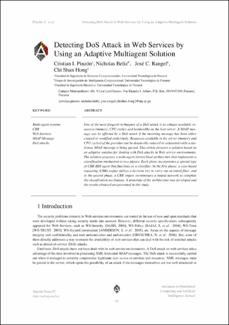Mostrar el registro sencillo del ítem
Detecting DoS Attack in Web Services by Using an Adaptive Multiagent Solution
| dc.contributor.author | Pinzón Trejos, Cristian | |
| dc.contributor.author | Beliz, Nicholas | |
| dc.contributor.author | Rangel, José Carlos | |
| dc.contributor.author | Hong, chi Shun | |
| dc.date.accessioned | 2018-06-07T19:13:27Z | |
| dc.date.accessioned | 2018-06-07T19:13:27Z | |
| dc.date.available | 2018-06-07T19:13:27Z | |
| dc.date.available | 2018-06-07T19:13:27Z | |
| dc.date.issued | 07/01/2013 | |
| dc.date.issued | 07/01/2013 | |
| dc.identifier | http://revistas.usal.es/index.php/2255-2863/article/view/ADCAIJ2012125763 | |
| dc.identifier.issn | 2255-2863 | |
| dc.identifier.uri | http://ridda2.utp.ac.pa/handle/123456789/4888 | |
| dc.identifier.uri | http://ridda2.utp.ac.pa/handle/123456789/4888 | |
| dc.description | One of the most frequent techniques of a DoS attack is to exhaust available resources (memory, CPU cycles, and bandwidth) on the host server. A SOAP message can be affected by a DoS attack if the incoming message has been either created or modified maliciously. Resources available in the server (memory and CPU cycles) of the provider can be drastically reduced or exhausted while a malicious SOAP message is being parsed. This article presents a solution based on an adaptive solution for dealing with DoS attacks in Web service environments. The solution proposes a multi-agent hierarchical architecture that implements a classification mechanism in two phases. Each phase incorporates a special type of CBR-BDI agent that functions as a classifier. In the first phase, a case-based reasoning (CBR) engine utilizes a decision tree to carry out an initial filter, and in the second phase, a CBR engine incorporates a neural network to complete the classification mechanism. A prototype of the architecture was developed and the results obtained are presented in this study. | en_US |
| dc.description.abstract | One of the most frequent techniques of a DoS attack is to exhaust available resources (memory, CPU cycles, and bandwidth) on the host server. A SOAP message can be affected by a DoS attack if the incoming message has been either created or modified maliciously. Resources available in the server (memory and CPU cycles) of the provider can be drastically reduced or exhausted while a malicious SOAP message is being parsed. This article presents a solution based on an adaptive solution for dealing with DoS attacks in Web service environments. The solution proposes a multi-agent hierarchical architecture that implements a classification mechanism in two phases. Each phase incorporates a special type of CBR-BDI agent that functions as a classifier. In the first phase, a case-based reasoning (CBR) engine utilizes a decision tree to carry out an initial filter, and in the second phase, a CBR engine incorporates a neural network to complete the classification mechanism. A prototype of the architecture was developed and the results obtained are presented in this study. | en_US |
| dc.format | application/pdf | |
| dc.language | eng | |
| dc.language.iso | eng | en_US |
| dc.rights | https://creativecommons.org/licenses/by-nc-sa/4.0/ | |
| dc.rights | info:eu-repo/semantics/openAccess | |
| dc.subject | Multi-agent system | en_US |
| dc.subject | CBR | en_US |
| dc.subject | Web Services | en_US |
| dc.subject | SOAP message | en_US |
| dc.subject | DoS Attacks | en_US |
| dc.subject | Multi-agent system | |
| dc.subject | CBR | |
| dc.subject | Web Services | |
| dc.subject | SOAP message | |
| dc.subject | DoS Attacks | |
| dc.title | Detecting DoS Attack in Web Services by Using an Adaptive Multiagent Solution | en_US |
| dc.type | info:eu-repo/semantics/article | |
| dc.type | info:eu-repo/semantics/publishedVersion |
